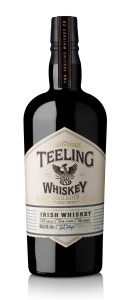Take it home: a craft beer hit and a wine designed for women
From the Irish Times Online Edition Friday 4th September, 2015

Brehon Brewhouse Stony Grey India Pale Ale
6% €3.50 for 500ml bottle
Those with literary pretensions will know immediately where this beer comes from. Seamus McMahon set up the Brehon Brewhouse in 2014, out the back of a working dairy farm – an opportunity for milk stout perhaps? He is in the parish of Killanny, close to Carrickmacross, Co Monaghan, home of poet Patrick Kavanagh.
“We started off at the Carrickmacross Festival in June 2014 with a festival ale,” says McMahon. “We made three thousand bottles and sold out within three days. Monaghan people really took to us and our beer. We got five taps in town within a week. Now we are in fifty pubs locally, across Louth, Cavan, Monaghan and Armagh. Monaghan Enterprise Board have been a great help too.” He is “absolutely loving it” but has his work cut out, looking after 120 cows at the same time. The brewer is Phil Bizzell, originally from Dublin, where he worked in L Mulligan Grocer, before joining Brehon. The core brands are their blonde and red beers, but they also now make the IPA above and a strong stout. “It is part and parcel of what we do as craft brewers,” says Bizzell. “Coming from Dublin, I have been very pleasantly surprised by the local reception. For most people it is their first time to drink craft beer. But most of the pubs who tried it out are keeping it.”
The Stony Grey has forward citrus hoppy aromas, plenty of refreshing lemon peel on the palate, balanced nicely with some malty notes, and a lightly bitter finish. Might it even bring back “the long hours of pleasure,” that Kavanagh lost in the stony grey soil of Monaghan?
 Ch de Nety 2014 Beaujolais Villages
Ch de Nety 2014 Beaujolais Villages
12.5% €8.99 from Aldi
Do women and men like different wines?
Beyond the clichés about Pinot Grigio, Prosecco and Girl’s Nights, do women prefer lighter, less alcoholic wines? I am generally cynical about award stickers on bottles of wine but I was intrigued by the gold medal on this one. It was given by the Concours Mondiale des Féminalise 2015. A little search on the internet revealed that the tasting panel in this competition is made up of all female wine professionals. I am not sure about the other award-winning wines, but the woman in my house certainly enjoyed this. Then again so did I. Do I have girly tastes? Looking at the website it does say that a medal “guarantees you a wine appreciated by women,” but then also adds “it is a wine that has all the requirements that appeal to men.” Phew!
Ch de Nety is very light, low in alcohol with delicate cherry fruits. It is refreshing; the French would call it gouleyant or lively. They would probably also call it a vin de soif or thirst-quenching wine. In other words, a pleasant wine to be enjoyed without too much fuss or any great palaver. Maybe that is what women like. It is also very cheap, so we can all enjoy it without damaging the credit card.
Posted in: Beer, Irish Times
Leave a Comment (0) →


 Mescan Red Tripel, Westport
Mescan Red Tripel, Westport Ch. Lorgeril 2011, Cabardès
Ch. Lorgeril 2011, Cabardès
 La Rosca Cava Brut NV
La Rosca Cava Brut NV Jean Claude Mas Piquepoul de Pinet Frisant 2013
Jean Claude Mas Piquepoul de Pinet Frisant 2013 Graham Beck Brut NV, South Africa
Graham Beck Brut NV, South Africa
 Tullamore D.E.W. Cider Cask Finish Irish Whiskey
Tullamore D.E.W. Cider Cask Finish Irish Whiskey Green Spot Ch. Léoville-Barton Single Pot Still Whiskey
Green Spot Ch. Léoville-Barton Single Pot Still Whiskey Midleton Dair Ghaelach Single Pot Still Whiskey
Midleton Dair Ghaelach Single Pot Still Whiskey
 Trimbach Riesling 2012
Trimbach Riesling 2012 Domaines Schlumberger Riesling Les Princes Abbés 2012
Domaines Schlumberger Riesling Les Princes Abbés 2012 Muré Riesling Grand Cru Vorbourg Clos Saint Landelin 2012
Muré Riesling Grand Cru Vorbourg Clos Saint Landelin 2012
 Santa Rita Secret Reserve White 2013, Casablanca, Chile
Santa Rita Secret Reserve White 2013, Casablanca, Chile Groiss Gemischter Satz Dorflagen 2014, Niederösterreich, Austria
Groiss Gemischter Satz Dorflagen 2014, Niederösterreich, Austria Ch. Sainte-Marie Alios 2012 Côtes de Bordeaux
Ch. Sainte-Marie Alios 2012 Côtes de Bordeaux
 Steininger Grüner Veltliner 2014, Kamptal
Steininger Grüner Veltliner 2014, Kamptal Birgit Eichinger Grüner Veltliner Hasel 2014, Kamptal
Birgit Eichinger Grüner Veltliner Hasel 2014, Kamptal Malat Grüner Veltliner 2014, Kremstal
Malat Grüner Veltliner 2014, Kremstal
 Mas de Daumas Gassac Blanc 2014
Mas de Daumas Gassac Blanc 2014 Jurancon, Clos Uroulat 2012
Jurancon, Clos Uroulat 2012 Bodegas Tradicion Amontillado Vors, Jerez
Bodegas Tradicion Amontillado Vors, Jerez
 Muscadet de Sèvre & Maine sur lie, Domaine de la Chauvinière 2013
Muscadet de Sèvre & Maine sur lie, Domaine de la Chauvinière 2013 Muscadet de Sèvre & Maine sur lie, Clos des Montys 2014
Muscadet de Sèvre & Maine sur lie, Clos des Montys 2014 Muscadet de Sèvre & Maine sur lie, Les Pierres Blanches, Domaine Luneau-Papin
Muscadet de Sèvre & Maine sur lie, Les Pierres Blanches, Domaine Luneau-Papin
 Teeling Whiskey Small Batch
Teeling Whiskey Small Batch Teeling Whiskey Single Malt
Teeling Whiskey Single Malt Teeling Whiskey 21 year-old Single Malt
Teeling Whiskey 21 year-old Single Malt